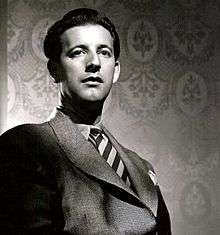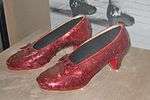Adrian (costume designer)
| Adrian | |
|---|---|
 | |
| Born |
Adrian Adolph Greenberg March 3, 1903 Naugatuck, Connecticut, U.S. |
| Died |
September 13, 1959 (aged 56) Hollywood, Los Angeles, California, U.S. |
| Occupation | Costume designer |
| Spouse(s) | Janet Gaynor (m. 1939–59) (his death; 1 child) |
Adrian Adolph Greenberg (March 3, 1903 — September 13, 1959), widely known as Adrian, was an American costume designer whose most famous costumes were for The Wizard of Oz and other Metro-Goldwyn-Mayer films of the 1930s and 1940s. During his career, he designed costumes for over 250 films and his screen credits usually read as "Gowns by Adrian". On occasion, he was credited as Gilbert Adrian, a combination of his father's forename and his own.
Early life
Adrian was born on March 3, 1903 in Naugatuck, Connecticut, to Gilbert and Helena (Pollack) Greenberg. Contrary to some sources, Adrian's father Gilbert was born in New York and his mother Helena in Waterbury, Connecticut. It was his grandparents, who were immigrants. Joseph Greenburg and his wife Frances were from Russia, while Adolph Pollak and Bertha (Mendelsohn) Pollak were from Bohemia and Germany, respectively. He entered the New York School for Fine and Applied Arts (now Parsons School of Design [1] in 1920. In 1922, he transferred to NYSFAA's Paris campus and while there was hired by Irving Berlin. Adrian then designed the costumes for Berlin's The Music Box Revue.
Career

Adrian was hired by Rudolph Valentino's wife Natacha Rambova to design costumes for A Sainted Devil in 1924. He would also design for Rambova's film, What Price Beauty? (1925). Adrian became head costume designer for Cecil B. DeMille's independent film studio. In 1928, Cecil B. DeMille moved temporarily to Metro-Goldwyn-Mayer and Adrian was hired as chief costume designer at the studio. While DeMille eventually returned to Paramount, Adrian stayed on at MGM. In his career at that studio, Adrian designed costumes for over 200 films.

During this time, Adrian worked with some of the biggest female stars of the day like Greta Garbo, Norma Shearer, Jeanette MacDonald, Jean Harlow, Katharine Hepburn and Joan Crawford. He worked with Crawford 28 times, Shearer 18 and Harlow 9. He worked with Garbo over the course of most of her career.[2] The Eugénie hat he created for her in the film Romance became a sensation in 1931 and influenced millinery styles for the rest of the decade.[3][4] Adrian was behind Crawford's signature outfits with large shoulder pads, which later spawned a fashion trend.
Adrian was most famous for his evening gown designs for these actresses, a talent exemplified in The Women. The Women (1939), filmed in black and white, it originally included a 10-minute fashion parade in Technicolor, which featured Adrian's most outré designs; often cut in TV screenings, it has been restored to the film by Turner Classic Movies. Adrian was also well known for his extravagant costumes, as in The Great Ziegfeld (1936) and opulent period dresses such as those for Camille (1936) and Marie Antoinette (1938). Adrian famously insisted on the best materials and workmanship in the creation of his designs.
Adrian is perhaps best known today for his work on the 1939 movie classic, The Wizard of Oz. Adrian designed the film's red-sequined ruby slippers for Judy Garland.
Adrian left MGM in 1941 to set up his own independent fashion house, though he still worked closely with Hollywood.
Sexuality and marriage

Though he was openly gay, he married Janet Gaynor in 1939, possibly in response to the anti-gay attitudes of the movie studio heads and the sex-negative atmosphere created by the Production Code.[5] They retired and remained married until his death in 1959. Gaynor and Adrian had one son, Robin (born 1940).
Later years and death
After leaving MGM, he established his own fashion house. He had been repeatedly courted by retailers to design for public sale, but rebuffed these offers. Macy's "Cinema Shop" copied his work with the studio's tacit approval, much in the same way that department stores produced "Paris" fashions, though they were unapproved copies of the French couturiers' works. He only returned to MGM for a final film, 1952's Lovely to Look At. Adrian was never nominated for an Academy Award as the costume category was not introduced during the time of his major work for the studios. A serious heart attack in 1952 forced the closure of Adrian, Ltd. in Beverly Hills. He and wife Janet bought a "fazenda" (ranch) outside of Brasilia in Brazil's interior and spent half of their year there. He came out of his retirement and returned to the States to design the costumes for "Grand Hotel," a musical version of the 1932 MGM film "Grand Hotel," which starred Paul Muni and Viveca Lindfors, but which only played in Los Angeles and San Francisco before Mr. Muni left the Broadway-bound show. In 1959 he was asked to design costumes for the upcoming Broadway musical Camelot. In the early stages of this project, Adrian died suddenly of a heart attack at the age of 56.[6] He was buried in Hollywood Forever Cemetery.
Filmography
|
|
|
|
References
- ↑ U.S. Census reports 1900, 1910
- ↑ "Screens: Review – Gowns by Adrian". The Austin Chronicle. Retrieved 2010-05-03.
- ↑ Robinson, David (5 January 1977). "Turning Women into Goddesses" (59900.). The Times.
- ↑ Grantland, Brenda; Robak, Mary (2011). Hatatorium: An essential guide for hat collectors (1st ed.). Mill Valley, CA: Brenda Grantland. p. 90. ISBN 9780984785902. Retrieved 26 July 2015.
- ↑ Habib, John Phillip (2002-07-09). "Dressmaker For Stars and Secretaries". The Advocate. Here Publishing (867): 61. ISSN 0001-8996.
- ↑ Blum, Daniel (1960). Screen World. 11. Biblo & Tannen Publishers. p. 215. ISBN 0-8196-0301-5.
- Baker, Sarah. Lucky Stars: Janet Gaynor and Charles Farrell. Georgia: Bear Manor Media, 2009. ISBN 1-59393-468-8.
- Stern, Keith (2009). "Adrian". Queers in History. BenBella Books, Inc.; Dallas, Texas. ISBN 978-1-933771-87-8.
External links
| Wikimedia Commons has media related to: |
- Gilbert Adrian Greenberg at the Fashion Model Directory
- Adrian at the Internet Broadway Database

- Adrian at the Internet Movie Database
- New York Times Biography dead link
- Adrian exhibit at the Metropolitan Museum of Art dead link
- Exhibit Notes and Gallery from Kent State dean link
- Adrian at DMOZ
- Hollywood Designers dead link
- Adrian Hollywood Designer dress